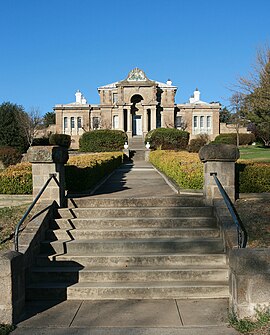Cooma
|
Cooma New South Wales |
|||||||||||||
|---|---|---|---|---|---|---|---|---|---|---|---|---|---|

Cooma Court House
|
|||||||||||||
| Coordinates | 36°14′06″S 149°07′33″E / 36.23500°S 149.12583°ECoordinates: 36°14′06″S 149°07′33″E / 36.23500°S 149.12583°E | ||||||||||||
| Population | 6,301 (2011 census) | ||||||||||||
| Established | 1849 | ||||||||||||
| Postcode(s) | 2630 | ||||||||||||
| Elevation | 800 m (2,625 ft) | ||||||||||||
| Location | |||||||||||||
| LGA(s) | Snowy Monaro Regional Council | ||||||||||||
| County | Beresford | ||||||||||||
| State electorate(s) | Monaro | ||||||||||||
| Federal Division(s) | Eden-Monaro | ||||||||||||
|
|||||||||||||
|
|||||||||||||
Cooma is a town in the south of New South Wales, Australia. It is located 114 kilometres (71 mi) south of the national capital, Canberra, via the Monaro Highway. It is also on the Snowy Mountains Highway, connecting Bega with the Riverina.
Cooma has a population of 6,301. Cooma is the main town of the Monaro region. It is 800 metres (2,620 ft) above sea level. The name could have derived from an Aboriginal word Coombah, meaning 'big lake' or 'open country'.
Cooma was explored by Captain J. M. Currie in 1823. It was first surveyed in 1840, and was gazetted in 1849. Cooma was proclaimed a municipality in 1879. Cooma is 5 kilometres (3 mi) south of the banks of the Murrumbidgee River, a main tributary of the Murray–Darling basin. Cooma sources its water from the river.
The railway from Sydney was extended from Royalla to Cooma in 1889 under the supervision of John Whitton. The line was closed to rail passenger traffic in 1989. The estimated population of Cooma was 47 in 1851 and it grew to 2330 (1911), 1969 (1933), 2249 (1947), 9103 (1966), 7353 (1976) and 7978 (1981).
In 1949, the town became the headquarters of the Snowy Mountains Scheme and grew rapidly. Those working on the Snowy Scheme depended on the railway and during construction of the scheme, the railways were one of the largest employers in the region. In 1959 the tenth anniversary of the scheme was celebrated with the erection of an avenue of flags representing the 27 nationalities of people working on the scheme.
Cooma has developed a growing tourism industry as it became the main rest stop for many travellers heading to the NSW snow fields during the winter months. As a result, the town nicknamed itself the 'Gateway to the Snowy Mountains'.
...
Wikipedia

